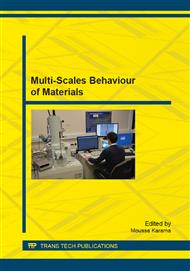[1]
R. Harzallah, A. Mouftiez, E. Felder, S. Hariri, J. -P. Maujean, Rolling contact fatigue of Hadfield steel X120Mn12, Wear 269 (2010) 647–654.
DOI: 10.1016/j.wear.2010.07.001
Google Scholar
[2]
F. Maratray, High Carbon Manganese Austenitic Steels, The International Manganese Institute, (1995).
Google Scholar
[3]
G. Collette, C . Crussard, A. Kohn, J. Plateau, G. Pomey, M. Weisz, Contribution à l'étude des transformations des austénites à 12 % Mn, Revue de Métallurgie LIV 6 (1957) 433-481.
DOI: 10.1051/metal/195754060433
Google Scholar
[4]
S. Bahattacharyya, A friction and wear study of Hadfield manganese steel, Wear 9 (1966) 451-461.
DOI: 10.1016/0043-1648(66)90136-0
Google Scholar
[5]
N. Jost and I. Schmidt, Friction induced martensitic transformation in austenite manganese steels, Wear 111 (1986) 377-389.
DOI: 10.1016/0043-1648(86)90134-1
Google Scholar
[6]
Zhang Fucheng, Lei Tingquan, A study of friction-induced martensitic transformation for austenitic manganese steel, Wear 212 (1997), 195-198.
DOI: 10.1016/s0043-1648(97)00156-7
Google Scholar
[7]
Guo-Shang Zhang, Jian-Dong Xing, Yi-Min Gao, Impact wear resistance of WC/Hadfield steel composite and its interfacial characteristics, Wear 260 (2006) 728–734.
DOI: 10.1016/j.wear.2005.04.010
Google Scholar
[8]
B.D. Shanina, H. Berns, Effect of surface work hardening on wear behavior of Hadfield steel, Materials Science and Engineering A 420 (2006) 47–54.
Google Scholar
[9]
Yuri N. Petrov, Valentin G. Gavriljuk, Hans Berns, Fabian Schmalt, The work-hardening behavior of medium manganese steel under impact abrasive wear condition, Wear 260 (2006) 687–691.
DOI: 10.1016/j.wear.2005.04.009
Google Scholar
[10]
W. Yang, L. fangs, K. Suna, Y. Xu, Effect of work hardening on wear behaviour of Hadfield steel, Materials Science and Engineering. A 460-461 (2007) 542-546.
DOI: 10.1016/j.msea.2007.02.094
Google Scholar
[11]
V.G. Gavriljuk, A.I. Tyshchenko, O.N. Razumov, Yu.N. Petrov, B.D. Shanina b, H. Berns, Corrosion-resistant analogue of Hadfield steel, Materials Science and Engineering A 420 (2006) 47–54.
DOI: 10.1016/j.msea.2006.01.066
Google Scholar
[12]
Weilin Yan, Liang Fang, Kun Suna, Yunhua Xu, Surface structure of stainless and Hadfield steel after impact wear, Materials Science and Engineering A 460–461 (2007) 542–549.
DOI: 10.1016/j.msea.2007.02.094
Google Scholar
[13]
W.R. Tyfour, J.H. Beynon, A. Kapoor, The steady state wear behaviour of pearlitic rail steel under dry rolling-sliding contact conditions, Wear 180, (1995) 79-89.
DOI: 10.1016/0043-1648(94)06533-0
Google Scholar
[14]
F.J. Franklin, G. -J. Weed, A. Kapoor, E.J.M. Hiensch, Rolling contact fatigue and wear behaviour of the infrastar two-material rail, Wear 258 (2005) 1048–1054.
DOI: 10.1016/j.wear.2004.03.054
Google Scholar
[15]
Ludger Deters, Matthias Proksch, Friction and wear testing of rail and wheel material, Wear 258 (2005) 981–991.
DOI: 10.1016/j.wear.2004.03.045
Google Scholar
[16]
M. Hiensch, P. -O. Larsson, O. Nilsson, D. Levy, A. Kapoor. F. Franklin, J. Nielsen, J.W. Ringsber, B. Lennart Josefson, Two-material rail development: field test results regarding rolling contact fatigue and squeal noise behaviour, Wear 258 (2005).
DOI: 10.1016/j.wear.2004.03.067
Google Scholar
[17]
A. Kapoor, F.J. Franklin, S.K. Wong, M. Ishida, Surface roughness and plastic flow in rail wheel contact, Wear 253 (2002) 257–264.
DOI: 10.1016/s0043-1648(02)00111-4
Google Scholar
[18]
Jiang Xiaoyu, Jin Xuesong : Numerical simulation of wheel rolling over rail at high-speeds. Wear 262 (2007) 666–671.
DOI: 10.1016/j.wear.2006.08.007
Google Scholar
[19]
Per Gullers, Lars Andersson, Roger Lundén, High-frequency vertical wheel-rail contact forces-Field measurements and influence of track irregularities, Wear 265 (2008) 1472-1478.
DOI: 10.1016/j.wear.2008.02.035
Google Scholar
[20]
Peter Pointner, High strength rail steels—The importance of material properties in contact mechanics problems, Wear 265 (2008) 1373–1379.
DOI: 10.1016/j.wear.2008.03.015
Google Scholar
[21]
Y. Satoh, K. Iwafuchi, Effect of rail grinding on rolling contact fatigue in railway rail used in conventional line in Japan, Wear 265 (2008) 1342–1348.
DOI: 10.1016/j.wear.2008.02.036
Google Scholar
[22]
J.E. Garnham, C.L. Davis, The role of deformed rail microstructure on rolling contact fatigue initiation, Wear 265 (2008) 1363–1372.
DOI: 10.1016/j.wear.2008.02.042
Google Scholar
[23]
D.T. Eadie, D. Elvidge, K. Oldknow, R. Stock, P. Pointner, J. Kalousek, P. Klauser, The effects of top of rail friction modifier on wear and rolling contact fatigue: Full-scale rail–wheel test rig evaluation, analysis and modelling, Wear 265 (2008).
DOI: 10.1016/j.wear.2008.02.029
Google Scholar
[24]
F.D. Fisher, M. Wiest, Approximate Analytical model for hertzian Elliptical Wheel/Rail or Wheel/Crossing Contact Problems, Journal of Tribology (2008).
DOI: 10.1115/1.2958074
Google Scholar
[25]
M. Wiest, W. Daves, F.D. Fischer and H. Ossberger, Deformation and damage of a crossing nose due to wheel passages, Wear 265 (2008) 1431-1438.
DOI: 10.1016/j.wear.2008.01.033
Google Scholar
[26]
M. Wiest, E. Kassa, W. Daves, J.C.O. Nielsen and H. Ossberger, Assessment of methods for calculating contact pressure in wheel-rail/switch contact, Wear 265 (2008) 1439-1445.
DOI: 10.1016/j.wear.2008.02.039
Google Scholar


